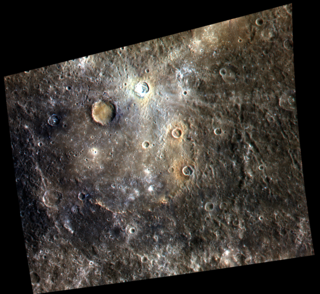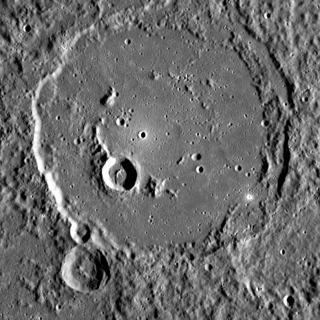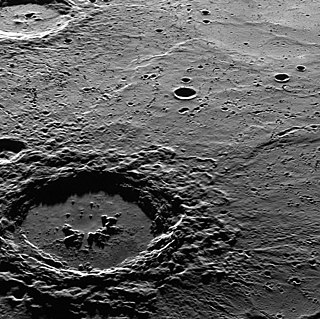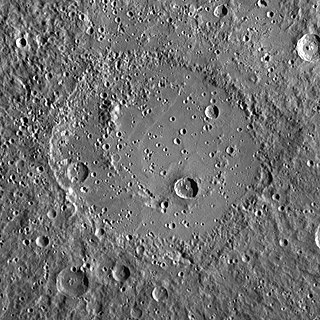
Degas is a rayed crater on Mercury at latitude 37.5 N, longitude 127 W. Its diameter is 54 kilometres (34 mi). It was named after the French impressionist painter Edgar Degas in 1979. The rays consist of light colored material blasted out during the crater's formation. Craters older than Degas are covered by the ray material, while younger craters are seen superimposed on the rays. Degas forms a crater pair with Brontë to the north. Both lie near the center of Sobkou Planitia.

Rodin is an impact crater on the planet Mercury, 230 kilometers in diameter. The rim is even and circular, except where it is broken in two places toward the north and south. It is named for the French sculptor Auguste Rodin. Its name was approved by the International Astronomical Union in 1976.

Bach is a double-ringed impact basin within the Bach quadrangle of Mercury. It was named by the IAU in 1976.

Michelangelo is a 230 km diameter impact basin in the Michelangelo quadrangle of Mercury, which is named after this crater. The crater itself was named by the IAU in 1979 after the Italian painter, sculptor and architect Michelangelo.

Vyāsa is a crater on Mercury. It was named by the IAU in 1979, after the Indian poet Vyasa. It is Tolstojan in age.

Homer is a crater on Mercury. It is one of 110 peak ring basins on Mercury. It is Tolstojan in age.

Polygnotus is a crater on Mercury, named by the IAU in 1976, after ancient Greek painter Polygnotus.

Hokusai is a rayed impact crater on Mercury, which was discovered in 1991 by ground-based radar observations conducted at Goldstone Observatory. The crater was initially known as feature B. Its appearance was so dissimilar to other impact craters that it was once thought to be a shield volcano. However improved radar images by the Arecibo Observatory obtained later in 2000–2005 clearly showed that feature B is an impact crater with an extensive ray system. The bright appearance of rays in the radio images indicates that the crater is geologically young; fresh impact ejecta has a rough surface, which leads to strong scattering of radio waves.

De Graft is a crater on Mercury. Its name was adopted by the International Astronomical Union in 2009, after Ghanaian playwright, poet, and novelist Joe de Graft.

Derain is a crater on Mercury named after André Derain, a French artist, painter, sculptor and co-founder of Fauvism with Henri Matisse. It has uncommonly dark material within and surrounding the crater. The material is darker than the neighboring terrain such that this crater is easily identified even in a distant global image of Mercury. The dark halo may be material with a mineralogical composition different from the majority of Mercury's visible surface. Craters with similar dark material on or near their rims were seen on the floor of the Caloris basin during MESSENGER’s first flyby.

Balzac is a crater on Mercury. Its name was adopted by the International Astronomical Union in 1976. Balzac is named for the French writer Honoré de Balzac, who lived from 1799 to 1850.

Dostoevskij is a crater on Mercury. It has a diameter of 430 kilometers. Its name was adopted by the International Astronomical Union in 1979. Dostoevskij is named for the Russian novelist Fyodor Dostoyevsky, who lived from 1821 to 1881. It is Tolstojan in age.

Dürer is a crater on Mercury. It has a diameter of 195 kilometers. Its name was adopted by the International Astronomical Union (IAU) in 1976. Durer is named for the German artist Albrecht Dürer, who lived from 1471 to 1528.

Handel is a crater on Mercury. It has a diameter of 166 kilometers. Its name was adopted by the International Astronomical Union in 1976. Handel is named for the British-German composer George Frideric Handel, who lived from 1685 to 1759.

Kālidāsā is a crater on Mercury. Its name was adopted by the International Astronomical Union in 1976. Kalidasa is named for the Indian writer Kālidāsa, who lived in the 5th century CE.

Lysippus is a crater on Mercury. Its name was adopted by the International Astronomical Union in 1976. Lysippus is named for the Greek sculptor Lysippos, who lived in the 4th century BCE.

Holst is a crater on Mercury. Its name was adopted by the International Astronomical Union (IAU) on April 24, 2012.

Ellington is a crater on Mercury named after Duke Ellington, an American composer, pianist, and leader of a jazz orchestra. It was named by the IAU in 2012.

Aneirin is a crater on Mercury. It has a diameter of 467 kilometers. Its name was adopted by the International Astronomical Union (IAU) on June 13, 2014. Aneirin is named for the Welsh poet Aneirin. Prior to naming, the crater was referred to as b37. It is Tolstojan in age.

Faulkner is a crater on Mercury. It has a diameter of 168 kilometres. Its name was adopted by the International Astronomical Union (IAU) on April 24, 2012. Faulkner is named for the American author William Faulkner.




















